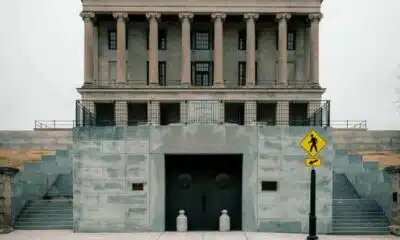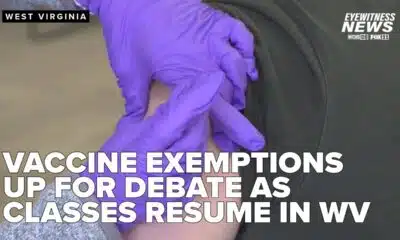News from the South - Texas News Feed
Texas proposes redrawing districts that concerned DOJ
“Texas’ proposed congressional map dismantles districts flagged by DOJ” was first published by The Texas Tribune, a nonprofit, nonpartisan media organization that informs Texans — and engages with them — about public policy, politics, government and statewide issues.
Sign up for The Brief, The Texas Tribune’s daily newsletter that keeps readers up to speed on the most essential Texas news.
In early July, as President Donald Trump was pushing Texas to redraw its congressional map to better favor Republicans, the Department of Justice sent state leaders a letter.
Four of Texas’ congressional districts were unconstitutional, the department warned. Three, the 9th, 18th and 33rd, were unconstitutional “coalition districts,” where Black and Hispanic voters combine to form a majority. The 29th, while majority Hispanic, was also unconstitutional, the letter said, because it was created by its two neighbors being coalition districts.
“It is well-established that so-called ‘coalition districts’ run afoul of the Voting Rights Act and the Fourteenth Amendment,” assistant attorney general Harmeet Dhillon wrote, threatening legal action if Texas didn’t bring the districts into compliance.
On Wednesday, Texas House Republicans released their first draft of a redrawn map designed to give the GOP five new seats in next year’s midterms.
As for the four districts that troubled Dhillon?
In the Houston area, the 9th and the 18th districts, where no one race currently constitutes a majority of eligible voters, would be redrawn as just over half Hispanic and half Black, respectively. But as a result, the nearby 29th District — a fixture of east Houston’s Latino community — would lose its Hispanic majority, becoming 43% Hispanic, 33% Black and 18% white.
The 33rd District in North Texas, although entirely redrawn, would still have no single racial or ethnic group that constitutes a majority.
Texas has long maintained that it drew these maps without an eye toward race. But tinkering with the lines now that these racial concerns have been raised risks triggering a Voting Rights Act complaint, legal experts said. States generally cannot redraw districts based on race without a compelling argument that it’s necessary to protect voters’ ability to elect their candidates of choice, said Justin Levitt, a redistricting expert at Loyola Law School.
“It sure seems like they have actually done what the DOJ, without any basis, accused them of,” Levitt said, noting that he had not done sufficient analysis to say for sure.
Legal experts say the DOJ’s interpretation of the law around coalition districts, and thus its legal threats to Texas, are based on faulty logic that could be backing the state into a discrimination lawsuit.
“Nothing in this decision suggests, much less holds, that the VRA prohibits the very existence of coalition districts,” Ellen Katz, a redistricting expert at the University of Michigan Law School, told the House redistricting committee at its first hearing last week. “There are hundreds of these districts nationwide in which jurisdictions relying on traditional principles create these districts.”
Coalition districts
Section 2 of the Voting Rights Act of 1965 says states cannot engage in election or voting practices that dilute the electoral power of voters of color, including by packing them into a single district or diffusing them throughout multiple.
For decades, courts held that states can satisfy the requirements of Section 2 by creating districts where multiple politically cohesive racial voting groups constitute a majority. Currently, Texas has nine districts where no one racial or ethnic group has a majority; in eight of them, Black, Hispanic and Asian voters combined create a majority.
In 2024, the 5th U.S. Circuit Court of Appeals, which hears Texas-based cases, reversed a prior ruling and said coalitions of different racial or ethnic groups within one district cannot claim their rights have been violated under Section 2 of the Voting Rights Act.
Citing this ruling, Dhillon told Texas that its coalition districts were “nothing more than vestiges of an unconstitutionally racially based gerrymandering past, which must be abandoned, and must now be corrected by Texas.”
But this reflects a misunderstanding of this case, legal experts say. Under this ruling, the Voting Rights Act can’t require states to create coalition districts, but that doesn’t mean coalition districts are inherently unconstitutional.
“All it says is that you don’t have the affirmative obligation to purposely create [a coalition district] at the outset,” said Mark Gaber, a lawyer with the Campaign Legal Center who is representing a group of plaintiffs in an ongoing lawsuit against the current maps. “It certainly doesn’t say, go through the map and eliminate all of the ones you drew.”
Texas leaders have contradicted themselves and each other on the question of whether the state has coalition districts and what should be done about them.
Gov. Greg Abbott, days after receiving Dhillon’s letter, included redistricting on his agenda for the Legislature’s special session, citing “constitutional concerns raised by the U.S. Department of Justice.” He later told Dallas’ Fox 4 News that redistricting was necessary because of the 5th Circuit’s ruling.
“We want to make sure that we have maps that don’t impose coalition districts while at the very same time ensuring that we will maximize the ability of Texans to be able to vote for the candidate of their choice,” he said.
At a House committee hearing Friday, GOP Rep. David Spiller of Jacksboro asked Rep. Todd Hunter, who carried the 2021 maps in the lower chamber, whether Texas currently has coalition districts. Hunter said “the law was different then.”
“You had coalition districts being interpreted differently,” he said. “Today, you have a 2024 5th Circuit case absolutely changing the law.”
But in court, Texas has long argued it has not drawn coalition districts to address racial disparities, because it draws “race blind” maps. Attorney General Ken Paxton doubled down on this argument in response to the Dhillon letter.
“The Texas Legislature has led the Nation in rejecting race-based decision-making in its redistricting process — it has drawn its current maps in conformance with traditional, non-racial redistricting criteria to ensure Texas continues to adopt policies that will truly Make America Great Again,” Paxton wrote.
At the request of Democrats, the House and Senate redistricting committees have invited Dhillon to testify on the letter and her allegations against Texas, but neither she nor any representative from the DOJ has responded to the request. The Senate panel this week voted not to subpoena her.
What happened to the Houston DOJ districts
Three of the districts Dhillon cited in her letter are neighbors in the Houston area. All three would be radically redrawn by the House’s proposed map.
The 9th Congressional District is a multiracial district made up of 45% Black voters, 25% Hispanic voters, 18% white voters and 9% Asian voters. The district, which covers parts of southwest Houston and outlying suburbs, voted for Vice President Kamala Harris in 2024 by 44 points, and has reliably reelected Democratic Rep. Al Green since 2004.
Under the House’s proposed map, the 9th District has been redrawn around an entirely new part of Houston, retaining just 2% of Green’s current district and scooping up conservative swaths of east Harris County. The Hispanic population would climb to just over 50% and the white population would almost double to 34%. Black voters would drop to 12% and Asian voters to 2%. In 2024, this new district would have voted for Trump by 15 points.
Green, who is essentially drawn out of his district, condemned the proposal as racist, saying “the DOJ demanded that the race card be played, and the governor dealt the people of Texas a racist hand.”
Republicans pointed to the changing preferences of Latino voters, who swung sharply for Trump and other GOP candidates in 2024, to defend these new lines.
“Each of these newly-drawn districts now trend Republican in political performance,” Hunter said. “it does allow Republican candidates the opportunity to compete in these districts.”
Some of Green’s existing district has been pushed into the newly drawn 18th Congressional District. While this was previously a seat with no single racial majority, its electorate would become 50.8% Black, while cutting the Hispanic and white populations. It would also tilt even further to the left; Harris carried the district by 40 percentage points in 2024 and would have won it by a 54-point spread under the new lines.
Next door, Rep. Sylvia Garcia’s 29th Congressional District would also be reconfigured, with Hispanic residents making up 43% of its new eligible voting population — down 20 percentage points from the current makeup. The district’s Black and white populations would increase to create a district without a single racial group dominating. It would become more strongly Democratic.
In challenging Texas’ maps, plaintiffs have contended that Houston’s population justifies two majority Hispanic districts. Instead, the one strong majority Hispanic district has been eliminated, and replaced with a district that is almost exactly half Hispanic, alongside one that is almost exactly half Black.
“50.5% is unlikely to perform for Latino preferred candidates, or Black preferred candidates,” Gaber said. “And they know that. It’s a mirage.”
What happened to the North Texas DOJ district
In her letter, Dhillon also said the 33rd Congressional District ran afoul of the Constitution through its coalition status. The district is currently anchored in Fort Worth, with an electorate that is 44% Hispanic, 25% Black, 23% white and 6% Asian. The district went for Harris by 34 percentage points and has consistently reelected Rep. Marc Veasey, a Black Democrat.
A decade ago, Texas, and the federal courts, asserted that the 33rd was not a coalition district.
“District 33 is not a ‘minority coalition opportunity district’ in which two different minority groups ‘band together’ to form an electoral majority,” the state and plaintiffs said in a joint advisory to the court. A district court judge agreed, saying it was “not intentionally drawn as a minority coalition district.”
The revised 33rd Congressional District maintains about a third of Veasey’s old district, moving out of his Fort Worth base. The proposed new lines would reduce the Hispanic and Black population and increase the white population, while maintaining about the same Democratic lean.
Just like in the current map, the proposed 33rd district does not have a single racial group that dominates. Legal experts say that is not inherently a problem, despite what the DOJ letter alleged, as long as voters of color have sufficient power to elect their candidate of choice.
At a House committee hearing last week, Nina Perales, the vice president of litigation at the Mexican American Legal Defense and Educational Fund, one of the groups suing over Texas’ current maps, testified that the Dallas-Fort Worth area, like Houston, should have an additional Hispanic-majority district on top of Veasey’s Hispanic-plurality seat.
“In light of the growth of the population over the past two decades, Section 2 of the Voting Rights Act does require the creation of additional districts,” Perales said. “If the committee and the legislature decides to take up redistricting, it is certainly true that you cannot subtract from the current level of representation that we have.”
Few districts in the Dallas-Fort Worth area went without major changes in the new draft map. In the reshaped downtown Dallas district of Rep. Jasmine Crockett, 50.2% of the voting population would be Black, not unlike the two new Houston districts to inch just past the majority threshold.
If Hispanic or Black voters were electing their candidate of choice, there is no legal reason to move more voters of one group into the district to hit a perfunctory benchmark of 50%, Levitt said.
“It tells me you’re trying really hard to hit a particular target, such that the target itself was the predominant reason for moving people in or out of the district,” Levitt said. “That’s exactly what the courts have said you can’t do.”
The lineup for The Texas Tribune Festival continues to grow! Be there when all-star leaders, innovators and newsmakers take the stage in downtown Austin, Nov. 13–15. The newest additions include comedian, actor and writer John Mulaney; Dallas mayor Eric Johnson; U.S. Sen. Amy Klobuchar, D-Minnesota; New York Media Editor-at-Large Kara Swisher; and U.S. Rep. Veronica Escobar, D-El Paso. Get your tickets today!
TribFest 2025 is presented by JPMorganChase.
This article originally appeared in The Texas Tribune at https://www.texastribune.org/2025/08/01/texas-congressional-redistricting-doj-coalition-districts/.
The Texas Tribune is a member-supported, nonpartisan newsroom informing and engaging Texans on state politics and policy. Learn more at texastribune.org.
The post Texas proposes redrawing districts that concerned DOJ appeared first on feeds.texastribune.org
Note: The following A.I. based commentary is not part of the original article, reproduced above, but is offered in the hopes that it will promote greater media literacy and critical thinking, by making any potential bias more visible to the reader –Staff Editor.
Political Bias Rating: Center-Left
This article leans center-left by presenting a detailed examination of Texas GOP-led redistricting efforts alongside critiques of the Department of Justice’s legal stance on coalition districts. It conveys perspectives from legal experts and civil rights advocates defending coalition districts and highlighting concerns about racial gerrymandering, which are commonly emphasized in progressive and Democratic viewpoints. Though it includes quotes and positions from Republican officials and the Texas Attorney General, the overall framing and choice of expert commentary tends to question GOP claims and actions, reflecting a center-left inclination without adopting a strongly partisan tone.
News from the South - Texas News Feed
DEA agents uncover 'torture chamber,' buried drugs and bones at Kentucky home
SUMMARY: Federal agents in London, Kentucky, investigating Scottie Shelton, discovered a disturbing “torture chamber” in a metal building on his property, complete with restraints and weapons. They found a strong odor of decay and buried drugs, including 6,000 oxycodone pills and 1,200 grams of methamphetamine. Shelton admitted to burying drugs and unintentionally forgetting their locations. Authorities also uncovered numerous unreported animal remains, including deer skulls and bobcat mounts, leading to 24 state wildlife violation counts. Shelton faces federal charges for possessing methamphetamine with intent to distribute and is held in Laurel County Detention Center under U.S. Marshal custody.
The post DEA agents uncover 'torture chamber,' buried drugs and bones at Kentucky home appeared first on www.kxan.com
News from the South - Texas News Feed
Abrego Garcia released from prison, headed to family
SUMMARY: Kilmar Abrego Garcia, wrongfully deported and imprisoned, has been released from a Tennessee jail and is en route to Maryland to reunite with his family, his lawyer Sean Hecker confirmed. Abrego Garcia was deported in March due to an “administrative error” and faced federal human smuggling charges related to a 2022 Tennessee traffic stop. His attorneys argue the prosecution is vindictive and selective, citing violations of his due process rights. A 2019 immigration ruling bars his return to El Salvador, and ICE is restricted from immediate custody post-release. The case continues amid concerns over potential re-deportation.
The post Abrego Garcia released from prison, headed to family appeared first on www.kxan.com
News from the South - Texas News Feed
Texas Senate expected to take up GOP congressional map
“Texas Senate expected to take up GOP congressional map, last stop before Abbott’s desk” was first published by The Texas Tribune, a nonprofit, nonpartisan media organization that informs Texans — and engages with them — about public policy, politics, government and statewide issues.
Sign up for The Brief, The Texas Tribune’s daily newsletter that keeps readers up to speed on the most essential Texas news.
The Texas Senate on Friday was expected to consider a new congressional map gerrymandered to maximize Republican representation, putting the plan on a path to the governor’s desk after weeks of intense partisan clashing.
Republican lawmakers were poised to push the map through over fierce Democratic opposition, launching a national redistricting war from Albany to Sacramento while positioning the GOP to net up to five additional seats in Texas.
The map, demanded by President Donald Trump to fortify the GOP’s U.S. House majority in next year’s midterm election, would hand up to five additional U.S. House seats to Republicans by dismantling Democratic bastions around Austin, Dallas and Houston, and by making two Democrat-held seats in South Texas redder. The new lines would also keep all 25 seats already held by Republicans safely red.
The pickups are meant to help the GOP hold onto its razor-thin congressional majority in a midterm election year that is expected to favor Democrats — potentially making the difference between a continued Republican trifecta in Washington, or a divided government with one chamber intent on investigating Trump and bottlenecking his agenda.
That has put Texas lawmakers at the front lines of an issue with national stakes. Republicans earned kudos from Trump for pushing the new boundaries through the state House, while Democrats won support from national party figures, including former President Barack Obama, Democratic National Committee Chair Ken Martin and U.S. House Minority Leader Hakeem Jeffries of New York.
Though congressional lines are typically redrawn once every 10 years following the decennial census, Republicans justified the aggressive and unusual move to do so in the middle of the decade by saying it was legal to craft new boundaries at any point and for purely partisan gain. They also pointed to the party’s margins of victory in 2024 and the need to counter blue-state gerrymandering to further support their push.
The U.S. Supreme Court ruled in 2019 that states can draw electoral maps on partisan grounds. But under Section 2 of the Voting Rights Act, the lines cannot diminish people’s voting power based on race.
Democrats argued that the new map would increase Republicans’ advantage by unconstitutionally suppressing the vote of Black and Latino Texans. They framed the push as a power grab by Trump meant to stack the deck in next year’s election.
Texas’ anticipated approval of the map has set off a tit-for-tat redistricting push in California, where Gov. Gavin Newsom has proposed a map voters would have to approve that could yield five new Democratic-leaning seats, effectively offsetting GOP gains in Texas. Other blue-state governors and national Democratic leaders are backing retaliatory gerrymandering as the Trump administration also pushes GOP-controlled Florida, Indiana, Missouri and Ohio to draw more red seats.
The new Texas map cleared its biggest hurdle Wednesday when, after more than eight hours of tense debate, the state House adopted the plan along party lines.
Lacking the votes to stop the map in the GOP-dominated Texas Legislature, more than 50 House Democrats staged a two-week walkout earlier this month, grinding the lower chamber to a halt by denying the quorum needed to conduct business.
Republicans unleashed an unprecedented response to drag them back to Texas, issuing civil arrest warrants, asking a court to extradite them from Illinois, seeking to declare over a dozen Democrats’ seats vacant and clamoring for legislative punishments upon their return.
After most Democratic lawmakers returned to Austin Monday, Republican Speaker Dustin Burrows, seeking to maintain a quorum, required each of them to agree to a police escort to leave the Capitol building. Rep. Nicole Collier, D-Fort Worth, refused and was confined to the Capitol for the next 54 hours, prompting a national media frenzy.
Democrats portrayed the walkout as a victory for sparking a national movement in support of retaliatory redistricting, and as just the first part of a longer fight against the map. In the House on Wednesday, Democratic lawmakers pressed their Republican colleagues on the plan’s impact on voters of color, working to establish a record they could use in a legal challenge seeking to kill the lines before next year’s election.
“This fight is far from over,” Rep. Gene Wu of Houston, chair of the House Democratic Caucus, said after the map’s passage in the lower chamber. “Our best shot is in the courts. This part of the fight is over, but it is merely the first chapter.”
More all-star speakers confirmed for The Texas Tribune Festival, Nov. 13–15! This year’s lineup just got even more exciting with the addition of State Rep. Caroline Fairly, R-Amarillo; former United States Attorney General Eric Holder; Abby Phillip, anchor of “CNN NewsNight”; Aaron Reitz, 2026 Republican candidate for Texas Attorney General; and State Rep. James Talarico, D-Austin. Get your tickets today!
TribFest 2025 is presented by JPMorganChase.
This article originally appeared in The Texas Tribune at https://www.texastribune.org/2025/08/22/texas-congressional-redistricting-map-senate-governor-desk/.
The Texas Tribune is a member-supported, nonpartisan newsroom informing and engaging Texans on state politics and policy. Learn more at texastribune.org.
The post Texas Senate expected to take up GOP congressional map appeared first on feeds.texastribune.org
Note: The following A.I. based commentary is not part of the original article, reproduced above, but is offered in the hopes that it will promote greater media literacy and critical thinking, by making any potential bias more visible to the reader –Staff Editor.
Political Bias Rating: Center-Left
The article focuses on the Texas congressional redistricting map, highlighting its Republican origins and the partisan conflict it has sparked. It provides detailed coverage of Democratic opposition and criticisms, including concerns about voter suppression among minority groups, and frames Republican efforts as a “power grab” led by Trump. The inclusion of national Democratic figures’ support for opposition and the emphasis on Democratic strategies and responses suggest a slight lean toward a Center-Left perspective. However, the article maintains a measure of balance by covering Republican justifications and legal points, which keeps it from tilting strongly left or right.
-
News from the South - Florida News Feed7 days ago
Floridians lose tens of millions to romance scams
-
News from the South - Texas News Feed7 days ago
New Texas laws go into effect as school year starts
-
News from the South - Alabama News Feed7 days ago
Final steel girders placed on new Gulf Shores bridge, completion on track
-
News from the South - West Virginia News Feed6 days ago
Religious exemption debate front and center amid new school year in WV
-
News from the South - Arkansas News Feed6 days ago
Trump, Zelenskyy exit White House talks hopeful about security guarantee for Ukraine
-
News from the South - Alabama News Feed5 days ago
U.S. agriculture secretary announces end to subsidies for solar panels on farmland
-
News from the South - Alabama News Feed6 days ago
Despite federal shift, state health officials encourage COVID vaccines for pregnant women
-
News from the South - Tennessee News Feed6 days ago
Push to eliminate sugar from SNAP plan












































